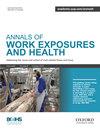194 化学防护手套对两种化学品混合物的渗透测试
IF 1.8
4区 医学
Q3 PUBLIC, ENVIRONMENTAL & OCCUPATIONAL HEALTH
引用次数: 0
摘要
我们对氯丁橡胶和氮化物制成的化学防护手套进行了两种化学品混合物的渗透测试。我们使用了三种药剂:(1) 甲醇和水;(2) 甲醇和 2-丙醇;(3) 甲苯和正己烷。结果显示,甲醇和水的药剂的突破时间随着甲醇浓度的降低而增加,当甲醇浓度为 10 % 时,我们发现最大渗透率低于每分钟 0.1 μg/cm2。我们还将报告其他化学混合物的渗透测试结果。本文章由计算机程序翻译,如有差异,请以英文原文为准。
194 Permeation test for a chemical protective glove against mixtures of two chemicals
We conducted a permeation test of a chemical protective glove made with neoprene and nitril against a mixture of two chemicals. We applied three agents such as (1) methanol and water, (2) methanol and 2-propanol, and (3) toluene and hexane. As a part of results, the breakthrough time of the agent of methanol and water increased as the methanol concentration decreased, and when methanol concentration is 10 % we found that the maximum penetration rate is lower than 0.1 μg/cm2 per minute. We will also report the permeation test results for other chemical mixtures.
求助全文
通过发布文献求助,成功后即可免费获取论文全文。
去求助
来源期刊

Annals Of Work Exposures and Health
Medicine-Public Health, Environmental and Occupational Health
CiteScore
4.60
自引率
19.20%
发文量
79
期刊介绍:
About the Journal
Annals of Work Exposures and Health is dedicated to presenting advances in exposure science supporting the recognition, quantification, and control of exposures at work, and epidemiological studies on their effects on human health and well-being. A key question we apply to submission is, "Is this paper going to help readers better understand, quantify, and control conditions at work that adversely or positively affect health and well-being?"
We are interested in high quality scientific research addressing:
the quantification of work exposures, including chemical, biological, physical, biomechanical, and psychosocial, and the elements of work organization giving rise to such exposures;
the relationship between these exposures and the acute and chronic health consequences for those exposed and their families and communities;
populations at special risk of work-related exposures including women, under-represented minorities, immigrants, and other vulnerable groups such as temporary, contingent and informal sector workers;
the effectiveness of interventions addressing exposure and risk including production technologies, work process engineering, and personal protective systems;
policies and management approaches to reduce risk and improve health and well-being among workers, their families or communities;
methodologies and mechanisms that underlie the quantification and/or control of exposure and risk.
There is heavy pressure on space in the journal, and the above interests mean that we do not usually publish papers that simply report local conditions without generalizable results. We are also unlikely to publish reports on human health and well-being without information on the work exposure characteristics giving rise to the effects. We particularly welcome contributions from scientists based in, or addressing conditions in, developing economies that fall within the above scope.
 求助内容:
求助内容: 应助结果提醒方式:
应助结果提醒方式:


